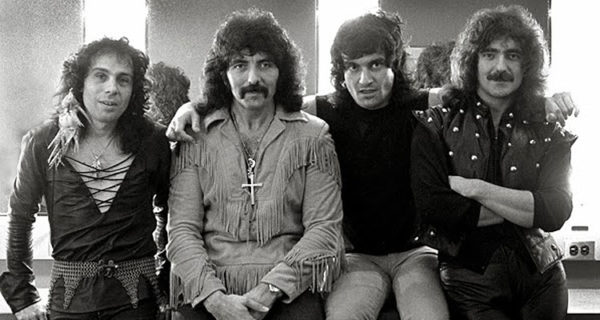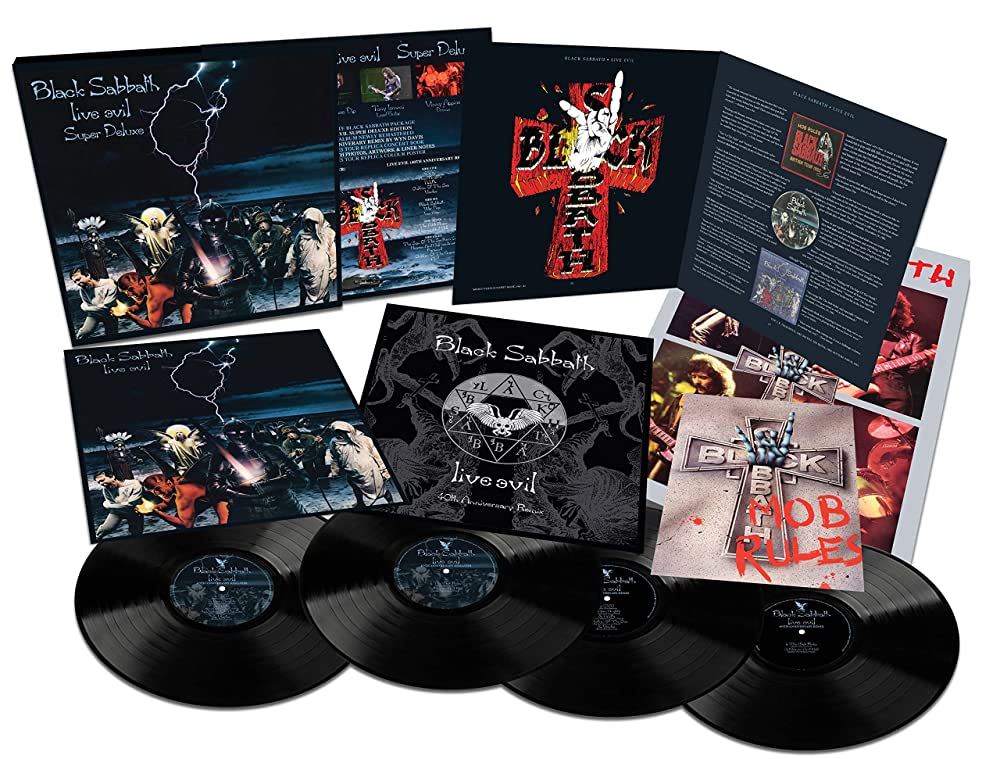Black Sabbath Rings In 40 Years of Live Evil
The first official live album by the godfathers of metal receives the super deluxe treatment

For what may have felt like a death knell for the godfathers of metal, vocalist Ronnie James Dio was a saving grace for Black Sabbath when in 1979 original vocalist Ozzy Osbourne made his exit. Dio brought forth some fresh approaches to the Sabbath mold, adding fantasy-based lyrics and more intricate vocal melodies. This allowed the band to write in a new direction and evolve further. The first offering of Black Sabbath Mark II, 1980’s Heaven and Hell, broke the slump spell that started with the lackluster results of Sabbath’s later-70s output. Reviews were mixed with its follow up, 1981’s Mob Rules, but it was still lauded by fans. Purists may have preferred this reinvigorated band to go under a different name, but the presence of Tony Iommi’s crunching riffs and the powerful rhythm section of bassist Geezer Butler & drummer Vinny Appice (Bill Ward’s replacement after Heaven and Hell) still had a Sabbath quality that made it worthy of bearing the moniker.
The backstory of Black Sabbath’s first official live album, Live Evil, is anything but harmonious. The driving force dates back to 1980 with the unauthorized release of Live at Last, an album consisting of live tapes from 1973 that were deemed unusable at the time. Former vocalist Ozzy Osbourne was also plotting his own live album entitled Speak of the Devil, which consisted of Sabbath material during his tenure with the band. Between both camps, it was an unspoken rivalry as to who could put out an album first. On Sabbath’s end, mixing sessions for Live Evil were, as described by Geezer Butler, “the Yanks against the Brits.” During the times Iommi & Butler often arrived late to the studio, Dio & Appice would ask mixing engineer Lee De Carlo to adjust some levels of the mix. This gesture got misconstrued to Iommi, who took it as Dio making his own vocals higher in the mix. Ultimately, this was the final nail in the coffin and Dio & Appice made their exit from the band. Despite this defunct lineup’s inability to promote the album, Live Evil still was both a critical and commercial success.
As early as 2021, Rhino in the US and BMG in the UK have been rolling out super deluxe editions of select Black Sabbath titles. These box sets include remastered albums, remixes, studio outtakes and unreleased live material. According to some insider sources, the Ozzy era has run its course with the super deluxe releases of Paranoid, Vol. 4, Sabotage and Technical Ecstasy. Where else to go than perhaps the second most significant era of Black Sabbath’s career: the Dio years. Just in time for its 40th anniversary, Live Evil is the next Black Sabbath to be given the super deluxe treatment.

The main focal point of reference for any super deluxe box set is the original album. The new remaster of the original mix of Live Evil takes up the first 2 LPs of this set. Listening to the original mix reminded me of how well Ronnie James Dio, with his more dramatic vocal style, reinvented some of the Ozzy material , particularly the tracks “Black Sabbath” and “Children of the Grave.” His maniacal laughs and ad-libs add a more sinister touch. Along with Dio, the rest of the band is on fire performance wise here. Even though turmoil was boiling amidst the album’s mixing sessions, the final mix isn’t unforgiving since the quality of the recording provides plenty of clarity. The flat sounding drums and reserved audience ambience are the only drawbacks that deter the mix from being “perfect” to the standards of a traditional live album.
After getting acquainted with the original mix, it was time to tackle the freshly prepared 40th anniversary remix by Wyn Davis. He has been Dio’s audio guru dating back to the mid ‘90s, having worked on various Dio and Dio-led Sabbath projects. Given the timeframe of this album, it makes sense for Davis to have a crack at reviving it.
Right off the bat, this new mix does improve upon some of the minor shortcomings of the original. Vinny Appice’s drums are more forward in the mix and the audience ambience is heightened, which only adds more to the live atmosphere. The remix allows each song to be experienced in its original unadulterated state from whichever show it was drawn from. “Neon Knights” sounds like an entirely different performance until the guitar solo, where it matches up identically to the original version. This confirms that a good amount of splicing between different performances was done to the original album in order to present a “perfect” performance, which is a common practice with assembling live albums. There is also some extra in-between stage banter from Dio that isn't heard on the original. It is only in retrospect that these minor elements of minutia can be appreciated by the most analytical listeners.
While the mix makes the album more lively, the mastering is what kills it. There is an excessive amount of compression applied to the point where the dynamics are completely eliminated and the drums sound processed. It is unknown whether this choice of compression was applied by Wyn Davis during mixing or when it was sent off to be mastered.
Chris Bellman is no stranger to mastering Black Sabbath on vinyl. His all-analog cuts of Vol. 4, Sabbath Bloody Sabbath and Sabotage from 2011 are the best sounding modern pressings of those specific albums. The original mix, digitally remastered by Andy Pearce & Matt Worham, is pleasantly dynamic. The bottom end provides plenty of “umph” and the high frequencies are crisp. The remix, mastered by Chris Behringer at Sterling Sound, moreso comes across as a giant wall of sound. Not to play devil’s advocate, but maybe that is what one would come to expect out of the godfathers of metal? Just don’t be too liberal on the volume knob because the ear fatigue will definitely settle in.
Sound quality aside, the packaging is what makes these super deluxe editions fun to delve into. The 40 page hardcover book includes an in-depth essay by Hugh Gilmour, along with photos and press clippings of the time. There are the usual bits of ephemera that one would come to find in a box set, particularly the replica tour programme and poster that’s suitable for framing. The artwork of the original album is faithfully replicated and there is some specially designed artwork for the remix. Each record came housed in a poly lined sleeve and Optimal Media GmbH did a phenomenal job pressing this release on quiet heavyweight vinyl with no visual defects.
If there is still a market that will buy these super deluxe sets, fans can only speculate what will come next. A remix of the ill-fated Born Again album with Ian Gillan? The long rumored box set featuring the Tony Martin albums? Let’s hope the Sabs give us the goods.














































